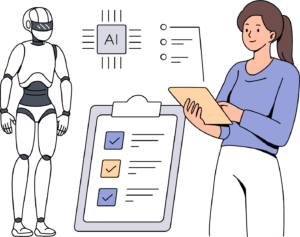People and artificial intelligence, unity is strength.

The growing increase in the complexity of society makes it necessary, regardless of the context in which he finds himself, that man must rely on technology to be able to carry out his work correctly and efficiently or live his life, from the correct functioning of your e-mail up to the reliability of the car with which you go to the office every day or to the school where your children go.
The construction of a good relationship between man and machine therefore becomes fundamental, because while it is true that new technologies make it possible to improve life, it is still important to remember that the first input must still come from man.
Just as the wheel was invented to facilitate the movement and transport of materials from one place to another and not to replace men’s legs, new technologies must represent tools that help people achieve their goals.
This is even more true in the corporate world, where organizations rely on new technological developments to streamline their processes, increase production value or their turnover. A clear example of how technological advances are giving a great hand to modern organizations is that of the digital transition and, in particular, of Artificial Intelligence, which allows us to analyze very large quantities of data in a very short time and extract precise analyzes from them in capable of helping (not replacing!) man in choosing the best strategy to implement to ensure that the company achieves its objectives.
So, just as we expect our emails to work accurately and our cars to drive reliably, we expect our AI models to work reliably and safely and if problems arise, you need to have of mechanisms that allow potential risks to be assessed and managed.
The first point to consider, for organizations that rely on new innovative technological tools such as Artificial Intelligence, is to maintain a human-in-the-loop approach, which requires humans to actively participate in the development and monitoring the effectiveness and accuracy of the models. In simpler terms, this means that data scientists are not replaced, but simply rely on special tools to combine their knowledge with technological capabilities. The wheels will move on the road on which they push them.
Once the AI model is created and deployed, it becomes important to continuously monitor its performance through regular collection of data on the model’s performance according to the set objectives. Monitoring checkpoints are critical to flag errors or unexpected results before deviations in performance occur. If deviations occur, the organization’s data scientists can evaluate what changes to make, such as retraining the model or discontinuing its use.
This human oversight adds an additional layer of reliability to the process. Additionally, workflow management can support future audit needs by tracking comments and change history.
In conclusion, systems that only operate under ideal conditions are not useful for organizations that need AI models that can scale and adapt to change. The effectiveness of a system depends on an organization’s ability to invest in a human-in-the-loop design that ensures data-driven systems operate reliably and securely and minimize potential risks, thereby reducing the potential for dangers such as vehicle breakdowns or essential emails being misclassified as spam.

But how can we invest in artificial intelligence while keeping the reins of analysis firmly in human hands?
Companies like BigProfiles provide their customers with an easy and intuitive artificial intelligence platform capable of analyzing very large quantities of data in a very short time, suitable for both industry experts and those with no knowledge of coding.
Thanks to it, the team of data scientists, together with operations and marketing, will have the possibility to predict the behaviors of their prospects or customers within their CRM and consequently set models capable of tracing the best possible strategy to succeed to achieve their objectives, be they acquisition, cross-selling, retention, or debt collection.
